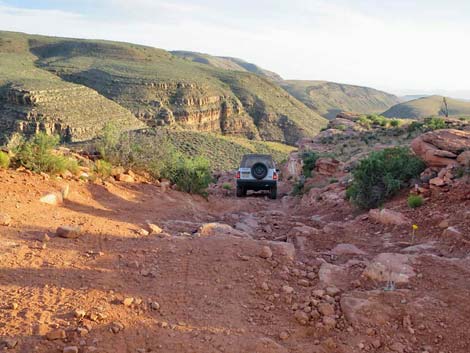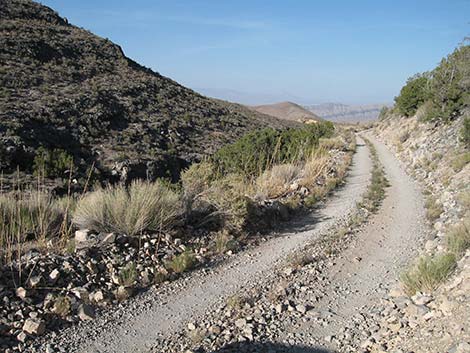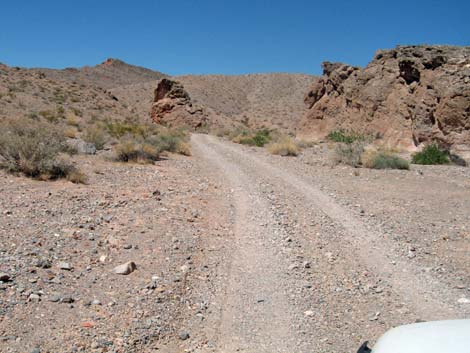
General Caution: When out driving, remember that as long as your vehicle keeps moving, everything will be fine. But the minute it stops because of flat tires, a busted oil pan, or just stuck in the sand, your life can be in danger. Be prepared with enough food and water to survive a day or two waiting for help to find you. Also, except in rare cases, stay with your vehicle -- search and rescue teams say it is much easier to find a vehicle than it is to find a person. Lie on the ground under your vehicle for shade if necessary.
 |
Four-Wheel-Drive (4WD) Dirt Roads. Four-wheel-drive (4WD) roads are designated roadways that might require driving over big boulders, driving in deep, soft sand or deep gravel, driving on steep, loose hillsides, and driving in situations where large rocks or soft substrates require traction and power to all four wheels and plenty of clearance under the vehicle. It only takes one such spot to make an otherwise ordinary road into a 4WD road. To me, the value of a 4WD vehicle is not to push the limits of the vehicle, but rather having the freedom to drive where I might get stuck in 2WD. Some people disagree, saying that 4WD only gives you the opportunity to get really stuck in really remote places. I usually drive in 2WD until the tires start slipping or I get stuck, then shift into 4WD and drive on or turn around, depending on the situation. |
 |
Two-Wheel-Drive (2WD) Dirt Roads. Two-wheel-drive (2WD) dirt roads range from well-maintained graded gravel roads that might be suitable in a sedan to old mining roads with a few bushes and rocks on the center hump that require a high-clearance suspension (e.g., SUVs and pickup trucks). Most 2WD roads were graded at some time in the past, although often they are not maintained. Keep in mind that a road suitable for a 2WD vehicle might quickly turn to a 4WD road when wet, and all it takes is one unexpected rock or a bit of deep sand to trap a sedan on what should be a 2WD road. When out in the desert with a 2WD vehicle, it is sometimes worth stopping, getting out of the vehicle, and inspecting a bit of road before trying to drive it. If you get stuck in a sandy place, letting some air out of the tires or putting on snow tire-chains can help. |
 |
Two-Track Dirt Roads. Two-track dirt roads are legal places where people have driven enough times to beat two tire tracks into the landscape (a road of sorts), but the ground has never been graded. Two-track roads may require a 4WD vehicle, although not necessarily, but the appearance is simply two ruts pressed into the soil. |
Happy hiking! All distances, elevations, and other facts are approximate.
![]() ; Last updated 240323
; Last updated 240323
| Main Glossary | Hiking Around Las Vegas | Copyright, Conditions, Disclaimer | Home |